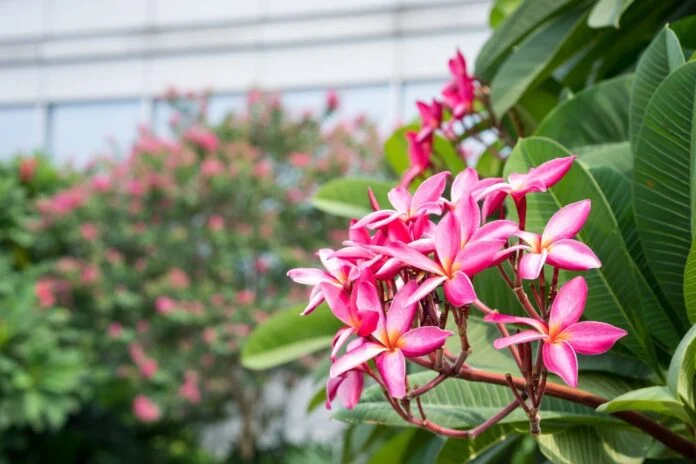This perennial is a South American flowering vine, and it thrives in tropical climes. Their tropical origins require higher temperatures north of 68° Fahrenheit to stay healthy and growing. This makes the plant grow best in USDA zones 10 and 11. They are, however, adaptable and can be made to thrive indoors to get overwintered in the other zones.
Its etymology is derived from the Greek words “diploos,” which means double, and “aden” meaning gland. It refers to the two glands of the ovary.
Dipladenia is also usually confused with Mandevilla. They may be similar and have significant features that are found in both plants. But they do have differences that are equally noticeable.
Here are some of the differences between Dipladenia and Mandevilla.
Differences Between Dipladenia and Mandevilla Plants
Dipladenia is also usually confused with Mandevilla. They may be similar and have significant features that are found in both plants. But they do have differences that are equally noticeable.
Here are some of the differences between Dipladenia and Mandevilla plants.
Dipladenia
They have smooth and shiny leaves with a shrub-like growth habit.
The flowers on these are smaller than those of the Mandevilla
It can grow both in containers as well as on trellises outside.
Mandevilla
They have a more vine-like growth habit and have longer, textured, and thinner leaves
Larger blooms than Dipladenia
Their creeper habit makes them good for arches and trellises
Dipladenias do not have any common names, but there are quite a few popular varieties of the plant. They are:
Costa Del Sol
Fire
Rio Dipladenia
Ice Fury
Stars and Stripes
Dipladenia Sundeville
Caring For Dipladenia and Mandevilla Plants
This plant can reach a height of about 12” to 24”. They must be planted about 8” to 12” away from each other when planting in flower beds. But they can grow to become taller than 8 feet if trained well.
The plant also needs to be trimmed regularly to ensure a consistent size.
They are known to flower between March and November. This makes it imperative for you to take care of the Dipladenia once the blooming session is complete. That way, the plant will get ready to bloom again in spring. The flowers also have a faint, soft fragrance that will fill your gardening space.
Sun Exposure
Dipladenias enjoy full sun and require about 6-8 hours of sun every day. You must ensure that the container your plant is in meets the light requirements. If you want to keep the plant outdoors, temperatures around the plant cannot drop anywhere below 60 degrees Fahrenheit either.
The best temperatures for Dipladenias is 65 to 72 degrees with a humidity level between 50% to 60%.
Being a tropical plant, the Dipladenia cannot survive colder conditions. If you hail from wintry climates, treat Dipladenia as an exotic annual and shift the plant indoors when the temperatures drop.
Water
Dipladenia needs a good amount of water when it is still young and growing. But once the plant is well grounded, watering it every 8-10 days would be enough. This plant requires more water when the weather turns hot. But you must make sure that the top level is dry before you water the plant because too much water could cause root rot.
Soil
These tropical beauties thrive in sandy or loamy soil with well-drained consistency. The pH range for the soil can vary between 6.6 to 7.8, but Dipladenias will grow in soils outside this pH range too.
Once the risks of frost are gone, you can transplant or repot the seedlings into the kind of soil best suited for the weather and the plant. You must move the seedlings during spring to welcome fragrant, gorgeous big flowers in midsummer.
If your plant is small and you want to move the plant into a larger pot, you must keep the root collar untampered. Soak the plant in the morning before moving it. And then water it again once planted in the new place.
After Care
Try to tease the roots that have the potential to move in different directions so that they grow out in the surrounding soil. Dipladenias can last for long periods in the same place they grow, so they may not need too much movement as they thrive while staying pot-bound.
But it is recommended that you transplant your Dipladenias biannually or annually to help them look their best.
Remember to remove the spent flowers so that new flowers can be encouraged to grow. Limiting the production of fruits will help your plant bear fresh flowers. Prune the plant when repotting.
Pests And Diseases
Dipladenias are not a difficult plant to grow when it comes to insects and illnesses, but they can be sensitive to some. Aphids, thrips, mealy bugs, and spider mites are the usual suspects, but they are equally easy to get rid of.
Here are repellants you can use to get rid of some of these plant irritants.
Sevin Sulfur Dust
Wilt-Pruf
Sage Plants
Wrapping Up
We hope this article helped you understand how to take care of Dipladenias. Plants are essentially exactly what you want them to be. Take care of them, give them what they need, and show them love. As a result, you get a healthy and thriving plant. Neglect is just not tolerated in the plant kingdom, especially when they are grown consciously.
If you have thoughts to share or questions to ask, please leave a comment below. We would love to hear from you!
AUTHOR BIO
Miranda Shaffer is a passionate blogger. She loves to share her thoughts, ideas, and experiences with the world through blogging. Miranda Shaffer is associated with Content Rally.

